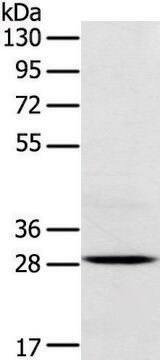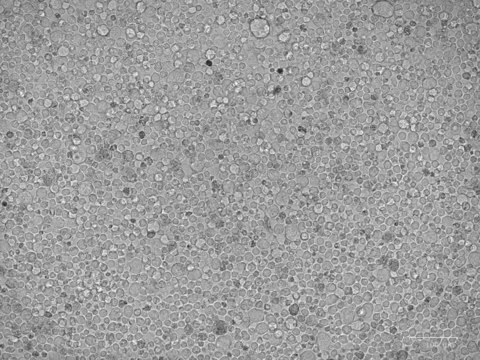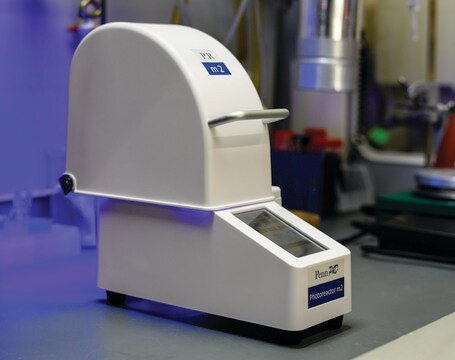詳細
We are committed to bringing you greener alternative products, which adhere to one or more of The 12 Principles of Green Chemistry. This antibody is Preservative-free, produced without the harm or sacrifice of animals and exceptionally stable to allow for ambient shipping and storage if needed and thus aligns with "Waste Prevention", "Designing Safer Chemicals" and "Design for Energy Efficiency".
Click here for more information.
ZooMAb® antibodies represent an entirely new generation of recombinant monoclonal antibodies. Each ZooMAb® antibody is manufactured using our proprietary recombinant expression system, purified to homogeneity, and precisely dispensed to produce robust and highly reproducible lot-to-lot consistency. Only top-performing clones are released for use by researchers. Each antibody is validated for high specificity and affinity across multiple applications, including its most commonly used application. ZooMAb® antibodies are reliably available and ready to ship when you need them.
特異性
Clone 1I11 is a ZooMAb® rabbit recombinant monoclonal antibody that specifically detects TREM2. It targets an epitope within 14 amino acids from the extracellular domain within the C-terminal half.
免疫原
KLH-conjugated linear peptide corresponding to 14 amino acids from the extracellular domain within the C-terminal half of human TREM2.
アプリケーション
Quality Control Testing
Evaluated by Western Blotting in RAW264.7 cell lysate.
Western Blotting Analysis: A 1:10,000 dilution of this antibody detected TREM-2 in RAW264.7 cell lysate.
Tested Applications
Western Blotting Analysis: A 1:1,000 dilution from a representative lot detected TREM-2 in lysate from Jurkat cells and 1:10,000 dilution detected TREM-2 in lysate from Human brain tissue.
Flow Cytometry Analysis: 1 µg from a representative lot detected TREM-2 in one million Jurkat cells.
Affinity Binding Assay: A representative lot of this antibody bound TREM-2 peptide with a KD of 2.0 x 10-8 in an affinity binding assay.
Immunocytochemistry Analysis: A 1:100 dilution from a representative lot detected TREM-2 in THP-1 cells.
Note: Actual optimal working dilutions must be determined by end user as specimens, and experimental conditions may vary with the end user.
ターゲットの説明
Triggering receptor expressed on myeloid cells 2 (UniProt: Q9NZC2; also known as TREM-2, Triggering receptor expressed on monocytes 2) is encoded by the TREM2 gene (Gene ID: 54209) in human. TREM-2 is a single-pass type I membrane glycoprotein that is synthesized with a signal peptide (aa 1-18), which is subsequently cleaved off to produce the mature form that contains an extracellular domain (aa 19-174), a transmembrane domain (aa 175-195), and a cytoplasmic domain (aa 196-230). TREM-2 is an Ig-like V-type receptor expressed by populations of myeloid cells in various region of the central nervous system. In the CNS strongest expression seen in the basal ganglia, corpus callosum, medulla oblongata and spinal cord. Its expression is also reported on macrophages and dendritic cells, but not on granulocytes or monocytes. TREM-2 is highly expressed in microglia, where it, along with its adaptor protein DAP12, regulates inflammatory cytokine release and phagocytosis of apoptotic neurons. It plays a role in chronic inflammations and may stimulate production of constitutive rather than inflammatory chemokines and cytokines. Its short cytoplasmic tail does not contain any signaling motifs and relies on its association with the immunoreceptor tyrosine-based activation motif- (ITAM-) containing TYROBP for signal transduction. It forms a receptor signaling complex with TYROBP and triggers activation of the immune responses in macrophages and dendritic cells. Apolipoprotein E (ApoE) is reported to function as a high-affinity ligand for TREM-2. ApoE binding is shown to enhance the phagocytosis of apoptotic Neuro2a cells by primary microglia cells. Greatly reduced ApoE binding is seen with Alzheimer s disease-associated TREM-2 R47H mutant. TREM2 gene mutations and polymorphisms have been linked to several neurological disorders, including Alzheimer s disease (AD), frontotemporal dementia (FTD), Parkinson s disease (PD), and Nasu-Hakola disease. This ZooMAb® recombinant monoclonal antibody, generated by our propriety technology, offers significantly enhanced specificity, affinity, reproducibility, and stability over conventional monoclonals. (Ref.: Zhao, Y., et al. (2018). Neuron. 97(5); 1023-1031; Ulland, TK., et al. (2017). Cell. 170(4); 649-663; Yeh, FL., et al. (2016). Neuron. 91(2); 328-340).
物理的形状
Purified recombinant rabbit monoclonal antibody IgG, lyophilized in PBS with 5% Trehalose, normal appearance a coarse or translucent resin. The PBS/trehalose components in the ZooMAb formulation can have the appearance of a semi-solid (bead like gel) after lyophilization. This is a normal phenomenon. Please follow the recommended reconstitution procedure in the data sheet to dissolve the semi-solid, bead-like, gel-appearing material. The resulting antibody solution is completely stable and functional as proven by full functional testing. Contains no biocide or preservatives, such as azide, or any animal by-products. Larger pack sizes provided as multiples of 25 µL.
再構成
300 µg/mL after reconstitution at 25 µL per vial. Please refer to guidance on suggested starting dilutions and/or titers per application and sample type.
保管および安定性
Recommend storage of lyophilized product at 2-8°C; Before reconstitution, micro-centrifuge vials briefly to spin down material to bottom of the vial; Reconstitute each vial by adding 25 µL of filtered lab grade water or PBS; Reconstituted antibodies can be stored at 2-8°C, or -20°C for long term storage. Avoid repeated freeze-thaws.
法的情報
ZooMAb is a registered trademark of Merck KGaA, Darmstadt, Germany
免責事項
Unless otherwise stated in our catalog or other company documentation accompanying the product(s), our products are intended for research use only and are not to be used for any other purpose, which includes but is not limited to, unauthorized commercial uses, in vitro diagnostic uses, ex vivo or in vivo therapeutic uses or any type of consumption or application to humans or animals.










